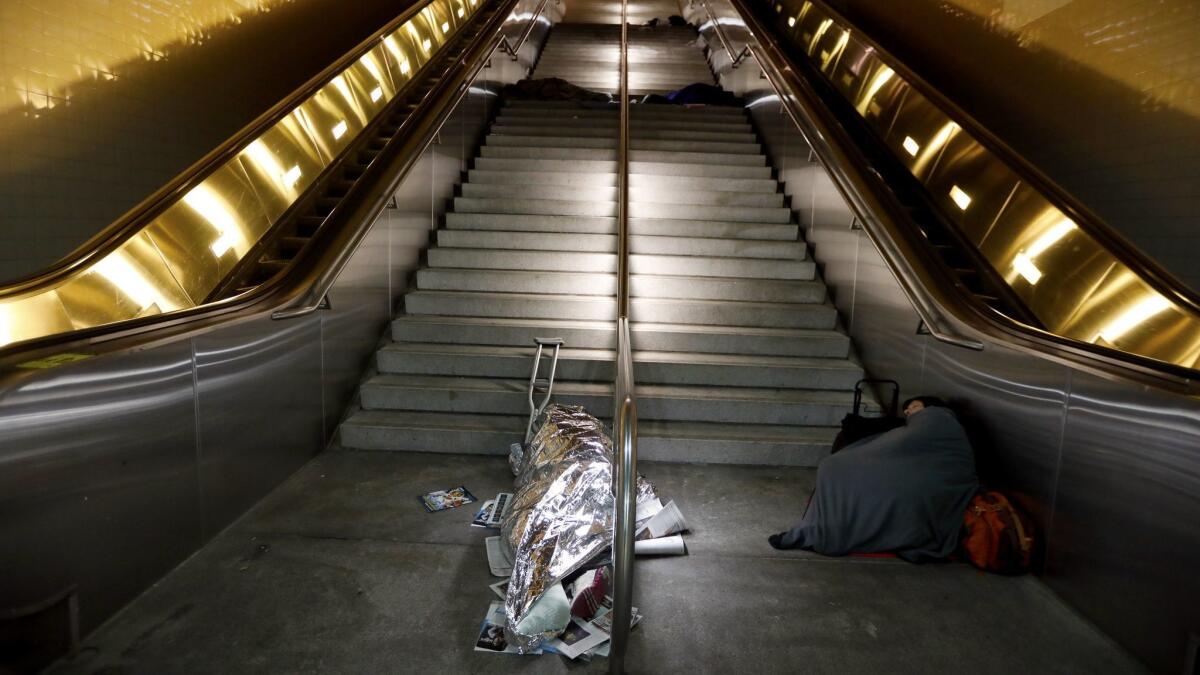Column: California’s housing crisis reaches from the homeless to the middle class — but it’s still almost impossible to fix

On Tuesday, the Los Angeles City Council gave housing advocates a lesson in why solving the statewide crisis in housing availability looks impossible to fix.
Voting 13 to 0 to oppose Senate Bill 827, which would loosen restrictions on high-density residential development around bus and rail stops, council members painted the measure as an all-out assault on the very fabric of community life in Los Angeles.
“Pure insanity,” declared Councilman Paul Koretz, who represents portions of the Westside and the San Fernando Valley. Councilman David Ryu, whose district includes Sherman Oaks, the Hollywood Hills, Los Feliz and the Wilshire Boulevard “Miracle Mile,” said that by creating “a housing boom for a privileged few and eviction notices for everyone else,” the bill would “uproot communities and destroy neighborhoods.”
Somewhere along the way, California decided that adding enough new housing is a bad thing.
— State Sen. Scott Wiener (D-San Francisco)
Those are strong words for a bill that is manifestly a work in progress and that already has been amended by its sponsor, Sen. Scott Wiener (D-San Francisco), to address local concerns. “What I asked of the L.A. City Council was to give us some space to work through issues in the bill,” Wiener told me. “We have had an open door for constructive feedback.”
But he’s plainly disconcerted by the intensity — indeed, the virtual unanimity — of the locally based opposition to SB 827. “Someone could write a case study about the truly odd coalition against this bill,” he says. The critics include not only local politicians but community activists, environmental groups such as the Sierra Club, some labor organizations, renters’ rights groups and even progressive healthcare advocates.
That’s remarkable for a bill that aims to bring down rents for low-income families, cut commuting times and pollution, and reduce overcrowding in residential units.
Somewhere along the way, Wiener says, “California decided that adding enough new housing is a bad thing.”
Opponents of the bill say SB 827 would open too many stable communities to ill-controlled growth. “With one broad brush, it rezones the urban state of California based on where a bus line runs,” says former Los Angeles City Councilman and county Supervisor Zev Yaroslavsky, who is currently director of the Los Angeles Initiative at UCLA’s Luskin School of Public Affairs.
There are many reasons for California’s failure to keep up with housing demand. One is the “incumbency effect” — existing residents are hostile to changes that might increase traffic, attract residents of lower income and different ethnicities, or produce other changes that could lower their property values. Existing residents who vote plainly have more clout with their elected officials than nonresidents waiting for a chance to move in.
Whatever the reasons for California’s housing shortage, the harvest is now coming in. The state will need anywhere from 1.8 million to 3.5 million new homes by 2025 to absorb existing demand and future population growth. But its current construction pace of fewer than 80,000 new homes per year falls short by 100,000 homes a year of meeting even the lowest estimate of demand.
And much of the construction is taking place inland, far from the coastal areas hosting most of the job growth. That combination increases urban sprawl, and only substitutes transportation costs for housing costs. In Stanislaus County, parts of which are bedroom communities for the San Francisco Bay Area, average annual housing costs are about $17,280, compared with the San Francisco average of $25,056, the state assessment says. But transportation costs for San Francisco residents average only $8,919, while those in Stanislaus average $13,519. It’s still cheaper to live near Modesto and commute, but the gap is narrow — not counting the time lost on the road.
“As affordability becomes more problematic, people ‘overpay’ for housing, ‘over-commute’ by driving long distances between home and work, and ‘overcrowd’ by sharing space to the point that quality of life is severely impacted,” warned the California Department of Housing and Community Development in its most recent housing assessment, issued in February.
The crisis threatens to cut the state’s economic boom off at the knees. The housing shortage costs California $140 billion a year — the equivalent of 6% of gross state product — according to a 2016 calculation by McKinsey & Co. That doesn’t include business opportunities or expansions forgone or relocations instituted by employers because they can’t recruit or keep workers in the state’s high-cost housing environment.
The most visible sign of the crisis is homelessness. One single sampled night in January 2015, California had nearly 116,000 homeless people — 21% of the national total, despite having only 12% of the U.S. population.
Indeed, the deepest shortfall in housing is for families earning 50% of the regional median income or less, for whom 1.5 million more units are needed. (The applicable median income for a family of four in Los Angeles County is $64,800, and in San Francisco County $115,300.) But the shortages are creeping ever higher on the income scale. In 2016, according to the 2018 housing assessment of the California Department of Housing and Community Development, the state faced a shortfall of more than a million units for households earning between 50% and 120% of the median wage; only for households earning 120% of the median or more was there even a modest surplus.
Subsidies and voucher programs exist to help low-income families spending more than 30% of their income on housing. But those programs are oversubscribed, and unlikely ever to be fully funded; providing housing assistance to all low-income Californians who don’t get it now would cost tens of billions of dollars, according to the state legislative analyst, making it the largest state expenditure outside of education.
The Legislature and Gov. Jerry Brown took major steps last year to address the crisis, enacting a package of 15 bills that streamlined the permitting and environmental review process for new housing, gave developers more incentives for projects that include units for low-income residents, and took some authority away from local communities that hadn’t met housing demand yet still were blocking new developments.
Some of these measures already seem to have borne fruit. A development firm has applied to fast-track a 2,400-unit project at a dying retail mall in Cupertino, exploiting the measure allowing builders to circumvent local approvals if they’re fulfilling unmet demand with at least half their units designated for affordable housing. Although Cupertino is the headquarters of Apple, its average home price of $1.8 million places it out of reach for the vast majority of the company’s employees.
“We’re confident that the package will result in significant inroads” in the housing shortage, says Ben Metcalf, director of the Department of Housing and Community Development. “We’re equally confident that more will be needed.”
The only real solution to the state’s housing crisis is to build more housing, including market-rate units for middle-class or even higher-income residents. It’s often supposed that loosening restrictions on market-rate housing will foment gentrification of lower-income neighborhoods, leading to forced evictions of their residents, but experts say that’s a myth.
UCLA housing expert Paavo Monkkonen and two university colleagues have found little evidence that construction of market-rate and luxury apartments has cannibalized the supply of housing for low-income families. Of the 104 Los Angeles apartment projects built between 2014 and 2016 that they examined, 26 were built on vacant or nonresidential parcels. Almost all the buildings demolished were small single-family homes, meaning that the projects resulted in a big gain in available units, more than a fifth of which were affordable housing.
“Los Angeles has not been systematically trading affordable housing units for luxury units for its wealthiest residents,” they concluded.
Wiener acknowledges that his bill may originally have defined transit corridors subject to higher-density development too loosely. His earlier amendments have strengthened controls on demolitions of existing housing and added more protection for occupants of rent-controlled units, including up to 42 months of rent if they’re displaced by new construction and the right to move into the new building at their old rent.
But he’s right to maintain that the ability of local authorities to block almost all new construction needs to be pared back if the housing crisis is to be solved. “Let’s be real,” he says. “In education and healthcare, the state sets basic standards, and local control exists within those standards. Only in housing has the state abdicated its role. But housing is a statewide issue, and the approach of pure local control has driven us into the ditch.”
Keep up to date with Michael Hiltzik. Follow @hiltzikm on Twitter, see his Facebook page, or email [email protected].
Return to Michael Hiltzik’s blog.



